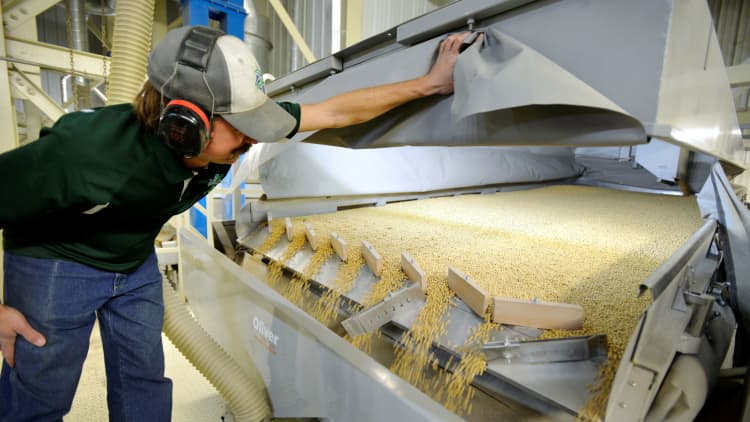
With President Donald Trump threatening that he’s "ready to go" with tariffs on more than $500 billion in goods from China, there's a possibility Beijing could inflict more pain on U.S. agriculture as part of retaliation, including another round of duties on soybeans.
If China were to add another round of duties on soybeans, it could add pressure on the Trump administration due to the economic importance of soy exports to China. However, the White House may have helped prepare for more pain in the American agriculture sector by rolling out a $12 billion emergency plan for U.S. farmers on Tuesday.
"Nobody is going to win in this trade war," said Bret Davis, an Ohio soybean farmer and a member of the American Soybean Association's governing committee. "We just hope instead of a tariff that we come to an agreement and make it better for our side and their side."
Still, there is precedent for China slapping "double whammy" tariffs months apart on the same U.S. agricultural products. For example, China imposed two rounds of tariffs on pork, nuts and fresh fruit. In the case of pork, after the additional tariff went into effect July 6, "the other white meat" is now subject to an import tax that exceeds 70 percent.
"You've already seen China express ways that they will probably get around soy," said Sam Funk, senior grain and oilseed analyst at Rabobank in St. Louis. The Chinese tariffs have already hit most lucrative sectors of agriculture, from grains and oilseeds to livestock and fresh produce. There have also been duties slapped on items such as dairy, nuts and wine.
If Beijing added a second wave of tariffs on U.S. soybeans, Funk said it could be done without Chinese buyers suffering the imported tax directly, such as by going through state-owned strategic reserves and then releasing some supplies internally. The Chinese government would presumably absorb the tariff, but if there were a double tariff the costs could increase sharply for Beijing.
A report earlier this month from Bloomberg suggested the Chinese government would reimburse buyers for costs of the new import duties, assuming the soybean cargoes are for state stockpiles. It cited unnamed sources for the information.
Pig feed and fish farms
China buys about two-thirds of the world's soybean exports, using most of it for soy protein to feed roughly 700 million pigs in the country or to make cooking oil. The soy also is used for feeding poultry and to support the country's fish farming sector.
The Chinese media, meantime, has been full of stories in recent weeks about how the country is no longer as dependent on the U.S. for its soybean needs, including how pork producers are using more alternative feeds, including cotton seeds and bone powder, and not seeing impacts in quality nor breeding.
Even so, an agricultural ministry official acknowledges prices of pork may go up due to price of soy imports rising.

Some US farmers can't cover the bills
There also is pain being felt in the U.S. farm sector due to Beijing's soybean tariffs. Chinese buyers have scrapped U.S. soybean orders in the past few months since the trade fight escalated and they have continued since the tariffs went into effect earlier this month.
Soybean prices have plunged nearly 20 percent since April when China first announced the 25 percent tariff on U.S. soybeans. That means farmers are getting lower prices for the commodity, and at these levels some are not making enough to cover bills. Beijing started collecting the tariff on U.S. soybeans on July 6.
"Cash prices are the lowest they've been in more than a decade," said Brennan Turner, president and CEO of the grain marketing business FarmLead. "If Washington and Beijing can't come to terms on major issues, this might be the new normal."
Also, the price China was paying for soybeans from Brazil — its top international supplier — rose sharply after the tariff was announced, so Beijing is paying a premium over the U.S. price. At the same time, the recent "bargain" prices for the U.S. beans appear to have sparked interest from other buyers, including Brazil and Mexico.
"Another tariff would mean another step down in price for soybeans, which will definitely put harvest prices below production costs for many producers across the country," said Chad Hart, an agricultural economist at Iowa State University in Ames.
According to Hart, some farmers are "doing well and can weather this financial storm quite easily. A bunch in the middle can handle this, but it will definitely erode their bottom line. And then we have some that were struggling before this tariff dispute really started, and this will push a few of them out of the door."
U.S. farm income has fallen about 50 percent since 2013 and is forecast to decline 6.7 percent this year, or the lowest level in nominal terms since 2006, according to the latest U.S. Department of Agriculture estimates.
China targets Trump states
Experts believe political factors drove Beijing to use soybeans as a weapon in the U.S.-China trade war. China buys roughly half of the U.S. soybean exports, and roughly one in three rows of soybeans grown on the nation's farms goes to the world's second-largest economy.
Top soybean-producing states include Illinois, Iowa, Minnesota, Nebraska, North Dakota, South Dakota, Indiana, Missouri, and Ohio. Trump won all but Illinois and Minnesota in the 2016 presidential election.
Last year, the U.S. exported about $20 billion of agricultural products to China and soybeans accounted for more than $12.2 billion of that amount.
Brazil remains the largest seller of soybeans to China, but its exports to China tend to be exhausted in the fall months or December. Analysts suggest China will need to buy some U.S. soy when South American supplies slow to a trickle, so they could use Beijing's strategic reserves to reimburse domestic users for the cost of the tariff or resort to other creative means.
"China is going to have to get soybeans from somewhere," said Funk, the Rabobank analyst. "It could be U.S. soybeans land somewhere [on a ship] and then turnaround and get a new designation as being from a new location."
WATCH: Trump weighs in on the trade war with China



